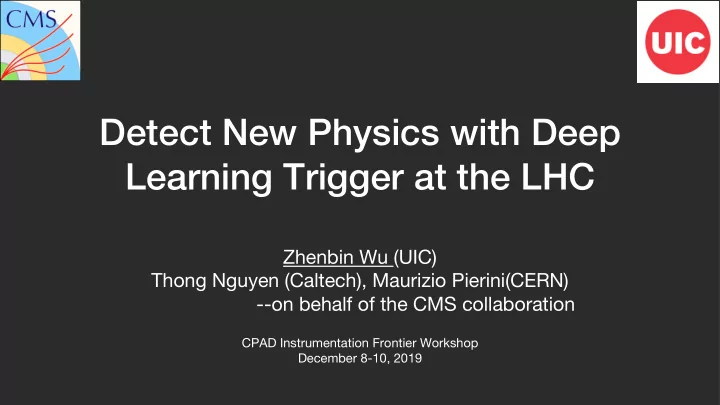

Detect New Physics with Deep Learning Trigger at the LHC Zhenbin Wu (UIC) Thong Nguyen (Caltech), Maurizio Pierini(CERN) --on behalf of the CMS collaboration CPAD Instrumentation Frontier Workshop December 8-10, 2019
The LHC Big Data Problem Data Flow HLT Farm L1 Trigger Offline Computing Data Analysis • 40M bunch crossing per second • Logging rate ~ 1kHz • Logging rate: ~100 kHz • Roughly 1GB/s data rate • Data rate ~1GB/s • User-written code, plots, • Non-zero suppressed RAW • Global reconstruction fully distributed over dozens of theses, talks, etc. data rate ~ 1PB/s primary datasets optimized for accuracy • ~100 papers of 10 MB • Zero suppressed data rate is • Simplified global with software implemented ~20TB/s each year, less than 1kB/s reconstructions on CPUs. • Coarse local reconstruction implemented on CPUs. implemented on FPGA/hardware. 2
Trigger at LHC • The interested physics productions are much smaller comparing to inelastic production • Trigger in LHC: finding a needle in a haystack scenario (anomaly) • Event not trigger will be lost forever! 3
Trigger at HL-LHC • The High-Luminosity of LHC: • Higgs, Flavour, Gauge Hierarchy, Supersymmetry, Dark Matter • O(100) GeV mass scales ➞ O(50) GeV endpoints ➞ O(20) GeV thresholds • Weak-scale physics ➞ Large statistics ➞ High luminosity ➞ Harsh environment! • Great effort on upgrading Phase 2 Trigger system at HL- LHC • Science potential of HL-LHC determined by datasets it collects
Workflow of Searches Pick a new model No Design deviation Trigger Collect Analysis Data 5
Workflow of Searches Pick a new model No Design De Deviatio Deviation Trigger n Collect Analysis Data 6
The LHC Big Data Problem A Drastic Data Reduction Data Flow L1 Trigger HLT Farm Offline Computing Data Analysis Could new physics have been discarded somewhere in this process? 7
Model-Independent Searches in HEP • Traditional new physics search relies on hypothesis testing with specific alternative models. • Motivated multiple attempts for model-independent searches in high-energy physics over the years. 8
An Alternative Approach • General approach by model-independent searches: • Look for discrepancy from the kinematic distribution of data versus expectation from Monte Carlo, taking into account of detector’s effects. • Look-elsewhere effect dilutes the discovery power with large number of bins. • ATLAS’ proposal: use the analysis to identify an excess, but establish the significance with a traditional method (supervised) on an independent dataset . Same spirit we have in mind for what follows… CERN-EP-2018-070 9
Autoencoders in a Nutshell Latent space • Compression-decompression algorithm that learns to describe the a given dataset in terms of point in lower-dimension latent space , from which it reconstructs the original data. • Unsupervised learning , used for data compression, generation, clustering, etc. • Anomaly: any event whose decompressed output is “far” from the input, in some metric of the autoencoder loss. Loss = f(input – output) 10
Autoencoders @ Level-1 Trigger Standard Triggers AE Triggers Trigger Threshold New Physics +others AE Reconstruction Loss • A Model-Agnostic Trigger for anomaly events with autoencoder (AE) model • Deployment at Level-1 trigger to avoid any bias from upstream • But limited by the resource and latency requirement on the Level-1 trigger system
CMS Phase 2 Level-1Trigger • Sketch of upgraded CMS Phase 2 Level-1 Trigger system • Produce Particle Flow particles, combining Calo/Muon/Tracker information • Produce PUPPI weight of each particles for pileup mitigation • Outputs of each trigger systems send to Global Trigger for Level-1 decision
Example AE Model • Train with simulated ZeroBias event at 200 pileup • Use simulated Puppi Jet/MET/MHT inputs (18 inputs) with preprocessing ReLU • Activation function: ReLU • Loss function: L1Loss • Training - validation ratio : 0.8 • Number of epochs: 100-200 epochs • Number of layers: 8 layers • Model is designed with simplicity for firmware implementation and resource/latency requirement
AE Performance • Model was trained and validated with simulated Zerobias events, no knowledge of signal during training • Use the reconstruction loss of AE inputs and outputs as discriminator • Inference with signal samples show the separation power Work in progress 14
AE Implementation • Use the hls4ml package to implement the AE model into FPGA firmware • With additional logic for L1Loss function calculation • Fully unroll AE with minimal latency, well within the Phase 2 Global Trigger latency budget • With Xilinx Virtex UltraScale+ (VU9P) FPGA, the AE consumes ~10% of DSP resource, ~1% of Filp Flop and LUT • To be included in the upcoming CMS Phase 2 Level-1 Trigger TDR
How to use the stream? Illustration by Jeff Lewonczyk • Not to claim a discovery! • Use as a resource to guide new physics searches in subsequent data takings, with some extra ingredients: • Data mining & visual inspection, • BSM-agnostic hypothesis testing. 16
Data Mining & Visual Inspection • Macroscopic and microscopic views of the saved data stream. • Learn any repeated patterns of events. • Select a set of anomalies for visual inspection. CMS-PAS-EXO-17-026 17
Learning New Physics from a Machine Agnolo & Wulzer, arXiv:1806.02350 • Use SM MC as null hypothesis, run hypothesis testing without specifying alternative hypothesis. • Allow for isolation of anomalous events by looking at their contribution to the likelihood ratio. 18
Conclusions • The LHC has an enormous potential of discovering physics beyond the Standard Model, given the unprecedented collision energy and the large variety of production mechanisms that proton-proton collisions can probe. • We propose a model-independent anomaly detection technique, based on deep autoencoders, to identify new physics events • Simple AE model can be implemented at the Level-1 trigger level • More advanced AE model can be designed for HLT or 40MHz scouting system (arXiv:1811.10276) • Stay tune for the CMS Phase 2 Level-1 Trigger TDR 19
BACKUP 20
Recommend
More recommend